Rottweiler vs. Doberman: Which breed is the right fit for you?

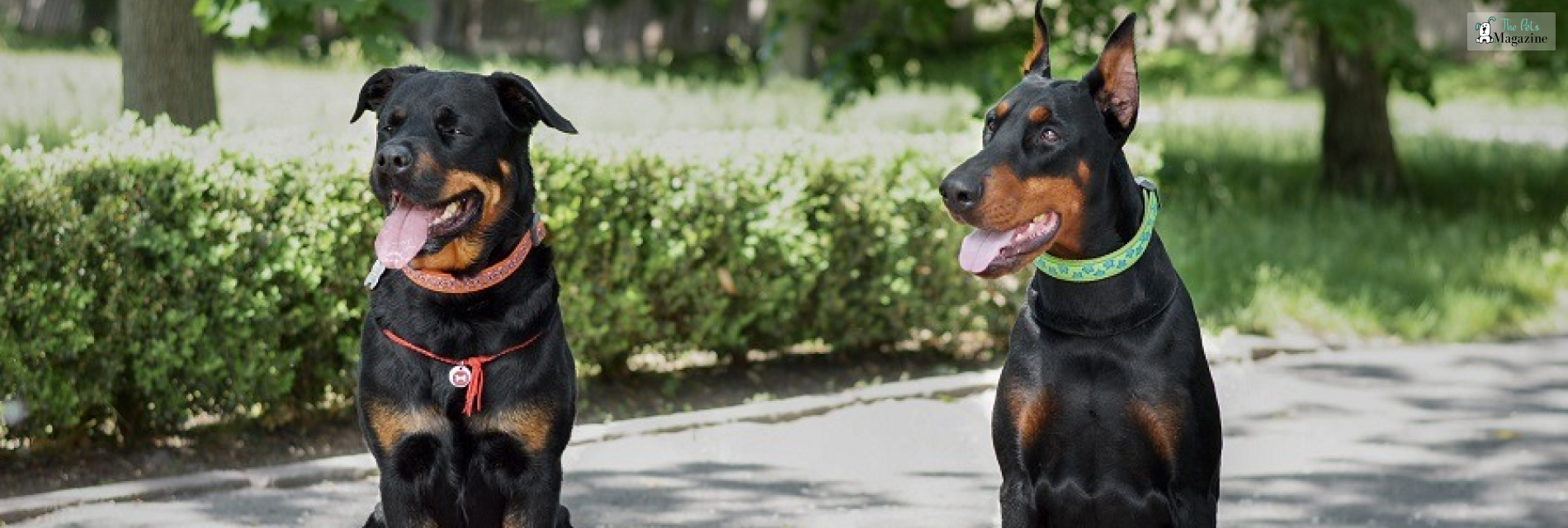
So you are thinking of getting a new dog for your family and are torn between Rottweiler vs Doberman? Both are large powerful breeds often used as guard dogs, so they can be intimidating. But they also make loyal companions and loving family pets. Since both breeds have a lot of similar characteristics, how do you choose between these two similar breeds?
Well, you have come to the right place! In this article, we will give you the scoop on the origin, temperament, health issues, exercise, and training needs of Doberman and rottweiler, so that you can determine which breed is the best fit for your family. Dive in to learn more about the Rottweiler vs Doberman dog breed.
Rottweiler vs Doberman: Exploring Their Origin and History
Rottweilers and Dobermans have a lot of things in common, and one of them is their birthplace. Both the dog breeds come from Germany and boast of a long and interesting history and origin story.
Rottweiler: History and Origin
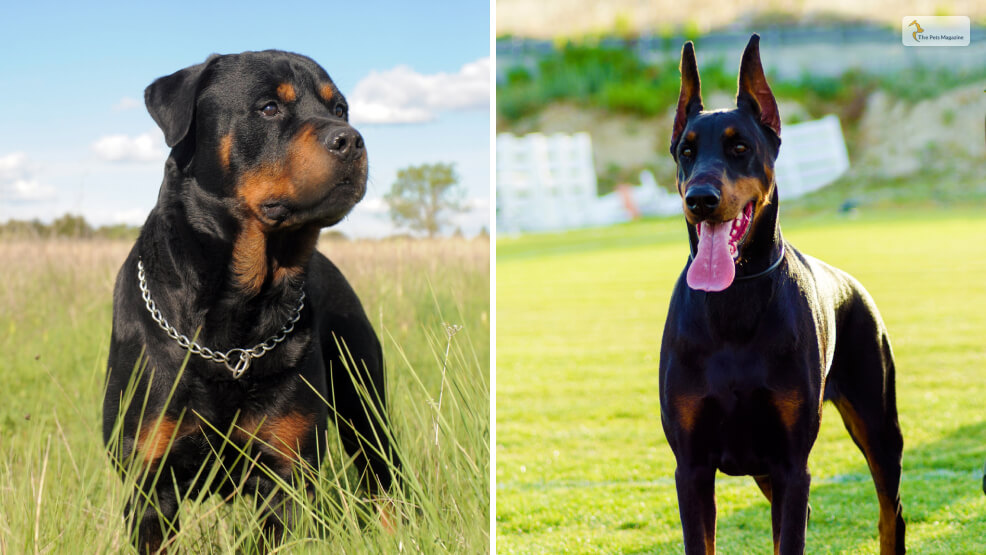
The Rottweiler hails from a place called Rottweil in Germany. It is believed that the Rottweilers are descendants of Mastiff-type dogs kept by Roman Legions for herding and guarding their cattle. These dogs accompanied the ancient Roman army as they marched through Europe.
But when the soldiers abandoned the places they had previously conquered, many of these mastiff dogs were left behind. In the region of Rottweil in Germany, the dogs left behind by Roman soldiers continued their work of herding and guarding cattle.
These dogs especially became popular with local butchers in Rottweil who not only used them to drive cattle but also to safeguard themselves against robbers and wild animals. The butchers would tie their money purses around the neck of these mastiff-type dogs to prevent them from getting stolen by robbers. These dogs were given the nickname ‘Rottweiler Metzgerhund’ which when translated in English means ‘Rottweil Butcher Dog’ because they helped the butchers to drive cattle and protected them against robbers. They have remained one of the top choices when it comes to dog breeds for home and family protection. But nowadays, Rotties are also gaining popularity as companion dogs.
Doberman Pinscher: Origin and History
The Doberman Pinscher dog also comes from Germany. The breed was created by a German tax collector named Karl Friedrich Louis Dobermann who was also a night watchman, dog catcher, and Skinner. He wanted a working dog breed that was strong, fearless, and intelligent with a calm temperament to help him with his tax collection.
It is not known exactly which dog breeds Karl used to develop the Doberman Pinscher. According to AKC (American Kennel Club), Karl most likely crossbred German Shepherds, German Pinschers (Pinscher is Terrier in German), Rottweilers, and Weimaraners to create the Doberman Pinscher.
Karl Dobermann’s main goal was to develop a guard dog breed that would be strong and fearless enough to outbrave anything and anyone. However, after his death, breeders began working on improving the breed’s appearance as well as his working ability. So at the turn of the 20th century, the Doberman pinscher was crossed with the Greyhound and the Manchester Terrier which resulted in giving the breed its signature, streamlined appearance. Now that you know the origin and history of these two dog breeds, scroll down below to get an overview of the two breeds.
Rottweiler vs Doberman: Breed Comparison
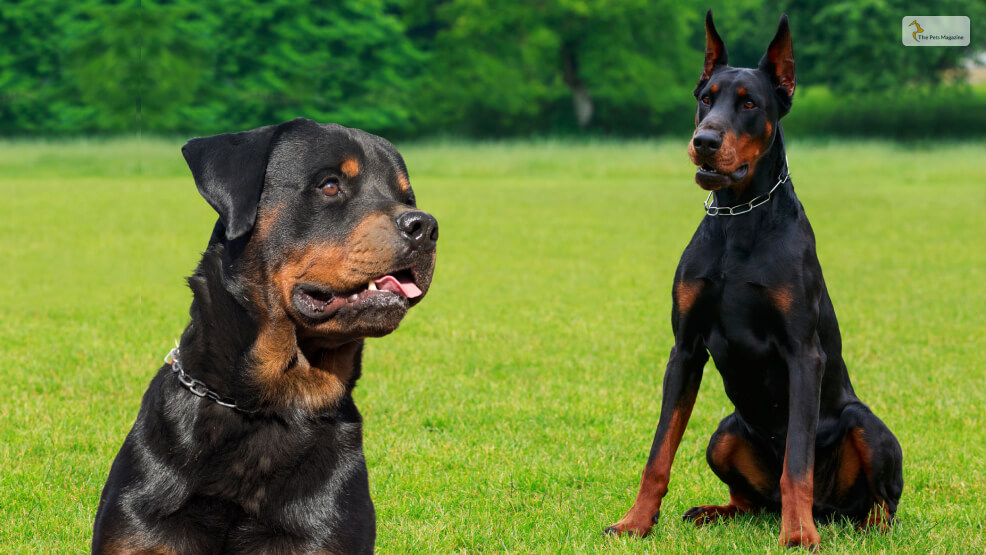
In the chart below, we have provided a comparison of the main physical features and personality/characteristic traits of Doberman vs. rottweiler.
| Physical and Personality Traits | Doberman | Rottweiler |
| Height | 24-26 inches (female)26-28 inches (male) | 22-25 inches (Female)24-27 inches (Male) |
| Weight | 75-100 pounds (male)60-90 pounds (female) | 80-100 pounds (Female)95-135 pounds (Male) |
| Lifespan | 10-12 years | 9-10 years |
| Coat Length | Short | Short |
| Coat Type | Smooth | Smooth |
| Grooming needs | Monthly | Monthly |
| Energy Level | Highly active | Moderately active |
| Barking Level | Medium | Low (Only to alert) |
| Temperament | Alert, Fearless, Protective, loyal | Loyal, Confident, loving, Protective |
| Sociable or not | Aloof towards strangers | Reserved towards strangers |
| Trainability | Eager to Please | Eager to Please |
If you want to know about the major physical characteristics and personality traits of rottweiler vs. Doberman at a glance then you can just go through the breed comparison chart given above. But if you want detailed information about these two breeds, then continue reading.
Rottweiler vs Doberman Size and Appearance
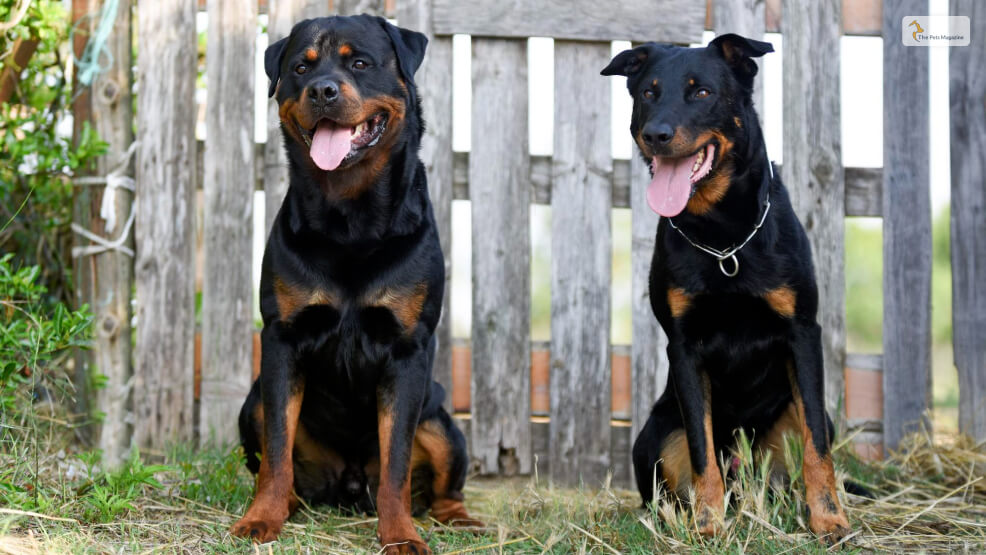
When comparing the Rottweiler vs Doberman breeds, size and physical appearance are two of the most noticeable differences. The Rottweiler is a larger, more robust breed. Males stand 24 to 27 inches at the shoulder and weigh up to 130 pounds, while females are 22 to 25 inches and 100 pounds.
Dobermans have a more slender, athletic build. Males are 26 to 28 inches tall and weigh 60 to 100 pounds. Females are 24 to 26 inches and 55 to 90 pounds. So if you prefer a larger guard dog, the Rottweiler may be better suited. For an agile companion, consider the Doberman.
Coat Pattern and Color
Rottweilers have a short, dense double coat – a soft undercoat and a coarse outer coat. They require frequent brushing to minimize shedding. Dobermans have a smooth, short single coat that sheds less.
When it comes to coat pattern and color of the coat, there is very little difference between the two breeds. Rottweilers are always black with distinctive rust or mahogany markings. Whereas, Dobermans come in four colors: black, red, blue, and fawn.
Black Dobermans have rust-colored markings, while Dobermans with other colors have tan markings. So if coat color is a priority, you have more options with the Doberman. However, the Rottweiler’s classic black and tan coloring is very distinctive and is a key identifying feature of this breed.
But if you are planning on bringing home a Rotterman, then you should know that a full-grown doberman rottweiler mix is a large breed dog that weighs around 80–120 lbs and can grow to a height of 25-28 inches.
Rottweiler vs Doberman Temperament and Personality
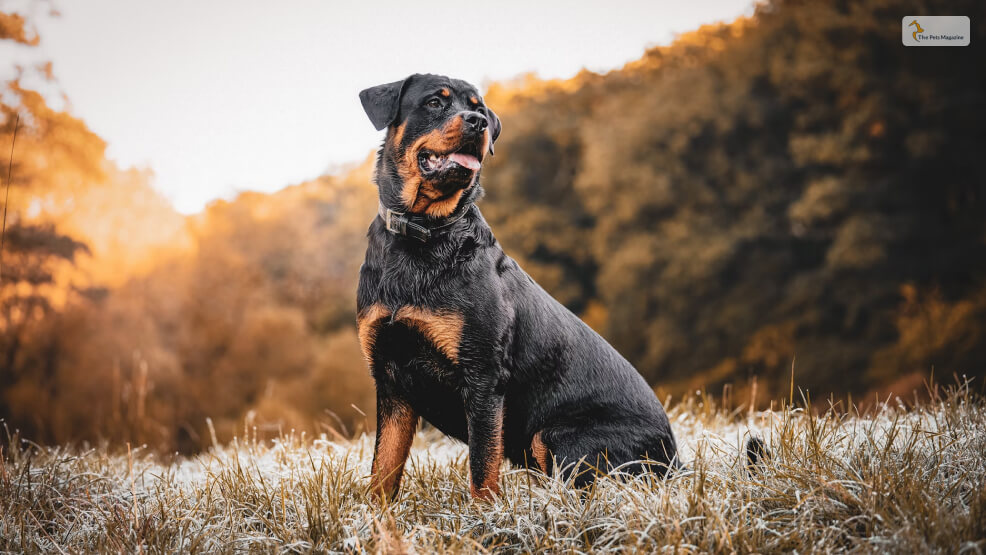
When it comes to temperament, there are some key differences between Rottweilers and Dobermans that are important to consider, especially if you have children or other pets.
What Kind Of A Temperament Does the Rottweiler Have?
Rottweilers are often portrayed as aggressive dogs, but that is an undeserved stereotype. In reality, Rottweilers are calm, confident, protective as well as courageous. At the same time, they are also devoted and loyal to their families, so they make great companions and guardians. When they are with their family members or loved ones, Rotties can be quite playful and affectionate.
However, they can be aloof or wary of strangers and unfamiliar dogs. Hence, early socialization and training are important to help them become more sociable and well-behaved around people and other animals outside the home. Well-trained and socialized Rottweilers are also quite gentle with young children if they are introduced properly.
What Kind of Personality and Temperament does the Doberman Have?
Dobermans, originally bred as guard dogs, are considered to be noblemen in the world of dogs because of their fearless and protective temperament. They are also watchful and alert and make excellent watchdogs. In addition, Dobermans are also very energetic, intelligent, and eager to please. With proper training and socialization from an early age, Dobermans can become quite friendly and social, even with strangers and other pets. They are playful, gentle, and patient with children and families they know well.
Since both dogs are quite similar in temperament, it is natural to wonder what the temperament of a rottweiler doberman mix also known as Rotterman will be. Well to start, the Rotterman dog breed will be a powerful, fearless, and intelligent breed. They will also make excellent watchdogs and guard dogs.
Rottweiler vs. Doberman Exercise Requirements
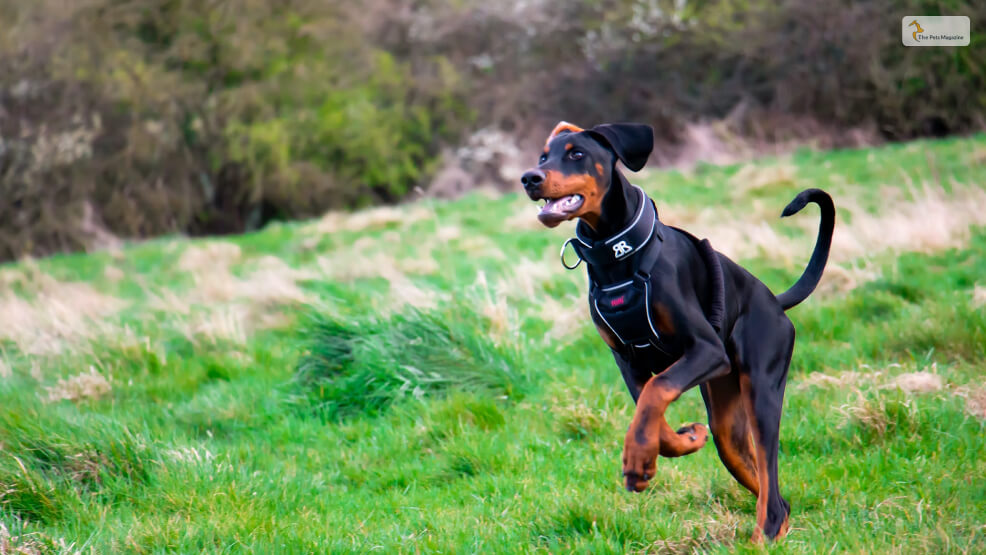
Dobermans were originally bred as guard dogs, so they have a high activity level and energetic temperament. An adult Doberman requires at least 1-2 hours of daily exercise. Some good options for a Doberman include:
- Going for jogs, hikes, or bike rides with their owner.
- Playing games that stimulate them mentally like fetch, tracking, obedience, agility courses, or learning new tricks.
- Running around in a securely fenced yard.
While Dobermans prefer active, involved owners, they can also adapt better to living in an apartment than a Rottweiler, as long as their needs for attention, physical and mental stimulation, and security are still met.
Rottweilers are large, energetic dogs that were originally bred as herding animals. They require daily exercise and attention, or they can become restless and even destructive. Moreover, the breed is prone to obesity. This is also one of the reasons why an adult Rottweiler requires at least 30-60 minutes of exercise per day to stay happy and healthy. These can include an array of activities such as:
- Going for brisk walks, jogs, hikes, or runs.
- Playing fetch or tug-of-war in a fenced yard.
- Doing obedience training or agility courses.
- Playing with interactive dog toys for mental stimulation.
You can also take your rottweilers for a swim but keep in mind that Rotties are poor swimmers. So you may need to give them some training initially.
Without enough activity and interaction, Rottweilers may engage in problematic behaviors like excessive barking, chewing, or aggression. They are not ideal for laid-back owners or families that can’t commit the time to properly exercising a large breed dog.
Overall, the Rottweiler may be a slightly lower-maintenance choice between these two breeds in terms of exercise requirements.
Rottweiler vs. Doberman Training Needs
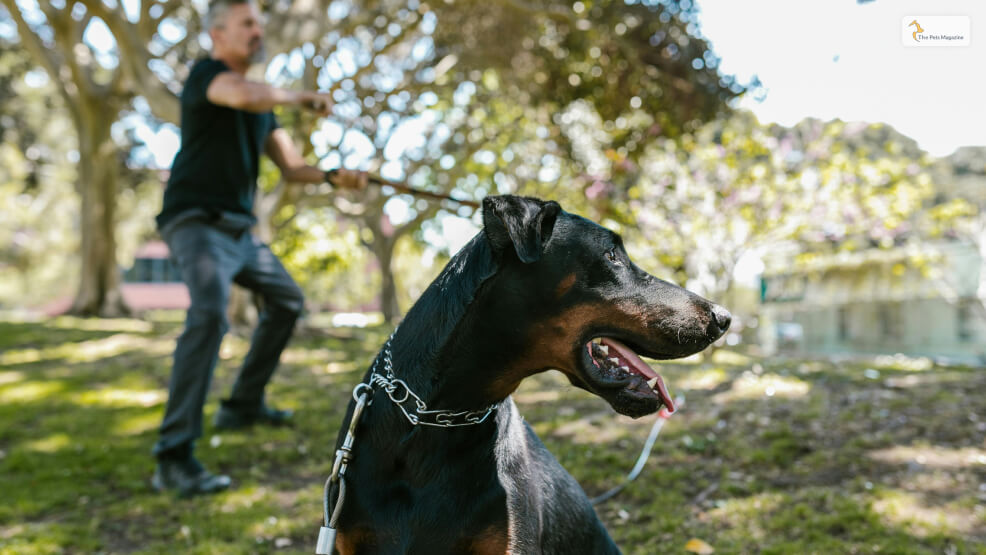
When it comes to trainability, the Rottweiler and the Doberman Pinscher are quite similar. Both are intelligent breeds that aim to please their owners, so with patience and consistency, either can make a great companion. However, there are a few differences in their temperaments and energy levels to consider.
The Doberman tends to be slightly easier to train because of their history of accompanying humans and protecting them. They are also highly trainable because the breed is intelligent and learns quickly.
The Doberman responds best to positive reinforcement training with treats, play, and praise. Harsher discipline will likely backfire. However, you need to be consistent and clear while training a Doberman. They need to understand clearly what the rules are and what they are expected to do.
Rottweilers can also be trained well, but require a firm and experienced hand. Originally bred as working dogs, Rotties are more independent-minded and can be stubborn at times. They have a lot of energy and stamina, so they need strong leadership and early socialization to become well-behaved family members. Rottweilers require lifelong obedience training and mental stimulation to prevent behavioral issues.
The most important thing to remember is that both breeds need experienced owners who are willing to put in the necessary time for consistent, positive, reward-based training and socialization. The same is true for a Doberman and rottweiler mix. The Rotterman will likely inherit traits such as intelligence, eagerness to please its owner, and stubbornness from both its parents and will need serious training and a lot of socialization. First-time owners may feel overwhelmed by the amount of effective dog training a rottweiler mixed with Doberman dog breed will require.
Rottweiler vs Doberman Health and Lifespan
When considering Rottweiler vs Doberman Pinscher, you’ll want to keep in mind the health issues common to each breed. Both breeds can be prone to certain medical conditions, so it’s important to find a reputable breeder that health tests their dogs.
Common Health Issues in Rottweilers
We have talked about some of the health issues that affect Rottweilers below:
Osteosarcoma
An unfortunate health issue seen in some Rottweilers is osteosarcoma, an aggressive form of bone cancer that primarily affects large and giant breed dogs. It is characterized by the malignant growth of bone cells.
Symptoms and Signs
- Lameness: Often the first sign, it can progress to severe pain and reluctance to move.
- Swelling: A noticeable lump or swelling may develop at the affected bone.
- Weight loss: Loss of appetite and weight can be associated with pain and discomfort.
- Fever: In some cases, a dog with osteosarcoma may exhibit fever.
The average Rottweiler has a lifespan of 9 to 10 years, though some live longer with proper care and exercise.
Common Health Issues in Dobermans
Some of the health issues that Dobermans are at risk of are as follows:
Dilated Cardiomyopathy
Dobermans are also prone to dilated cardiomyopathy, a life-threatening heart condition. It is characterized by the enlargement of the heart’s chambers, particularly the left ventricle. This enlargement weakens the heart’s ability to pump blood effectively.
Symptoms and Signs:
- Lethargy: Dogs with DCM may become tired easily or seem less active.
- Coughing: A persistent cough, especially when lying down, can be a symptom.
- Difficulty breathing: Shortness of breath or rapid breathing can occur.
- Swollen abdomen: Fluid buildup in the abdomen (ascites) can be a sign of heart failure.
- Fainting or collapse: In severe cases, dogs may faint or collapse due to insufficient blood flow.
Liver Disease
Dobermans are prone to several liver diseases, some of which are unique to this breed. These are as follows:
- Doberman Pinscher Inherited Hepatopathy (DPIH): Jaundice, lethargy, vomiting, and weight loss are some of the symptoms. There is no cure yet but dietary management and medication can help manage symptoms.
- Hemochromatosis: This condition involves the excessive accumulation of iron in the liver and the symptoms are same as other liver disease. The only treatment are bloodletting to remove excess iron and dietary management.
The average Doberman lives 10 to 12 years, though some reach 13 or 14 with good care.
Both Dobermans and Rottweilers are susceptible to hip and elbow dysplasia, which can require expensive surgery to correct. They are also prone to certain eye diseases and heart problems.
As large breed dogs, Rottweilers, and Dobermans require scheduled veterinary care to monitor for health issues. You’ll want to schedule regular checkups, especially as they get older. Early diagnosis of medical conditions can help prevent suffering and allow for better treatment options.
Providing high-quality food specifically for large breed dogs, limiting excessive running and jumping as puppies, and keeping your dog at a healthy weight can also help reduce health risks.
Rottweiler vs. Doberman Suitability as Family Pets
When deciding between a Rottweiler vs Doberman Pinscher, think about which traits will suit your family and lifestyle best. Both breeds can make loyal companions, but there are some key differences, mainly in terms of their energy levels.
Dobermans generally have a higher energy level than Rottweilers. They require daily exercise, play, and mental stimulation. Rottweilers are comparatively less active but prone to obesity so they need daily exercise. They also need a lot of living space because of their size. On the other hand, Dobermans can adjust to life in apartments if their daily need for exercise is met.
So if you lead an active lifestyle and want an eager companion for jogs, hikes, or play, a Doberman could be ideal. A Rottweiler may be better suited for a family that is slightly laid back.
Both these breeds make excellent family pets when trained and socialized properly from a very young age and are safe to be around children. Dobermans prefer to bond with one person so they are better suited for small families. Rottweilers on the other hand, are perfect for large families with children, as they can act as guard dogs and also cuddle and play with children at the same time.
However, both Rottweilers vs Dobermans are powerful, intelligent dogs that require experienced, confident owners. They are not ideal for first-time dog owners. So if you’re looking for an easygoing breed, neither of these may be the right choice.
Final Thoughts
At the end of the day, you need to think about your own lifestyle and what you’re looking for in a dog. The Rottweiler might be your best bet if you want a gentle giant. If you prefer a dog that is intelligent and vigilant, then the Doberman Pinscher could be the perfect match. Bringing home a dog is a big decision, so take your time to research and choose the breed that fits you. But with either a Rottie or a Doberman by your side, you’ll have a faithful friend for life.
So what do you think of the Rottweiler and the Doberman dog breed? Would you consider bringing home any one of these breeds? Or, would you prefer a Doberman and Rottweiler mix? Tell us in the comments below!
Have you read these?








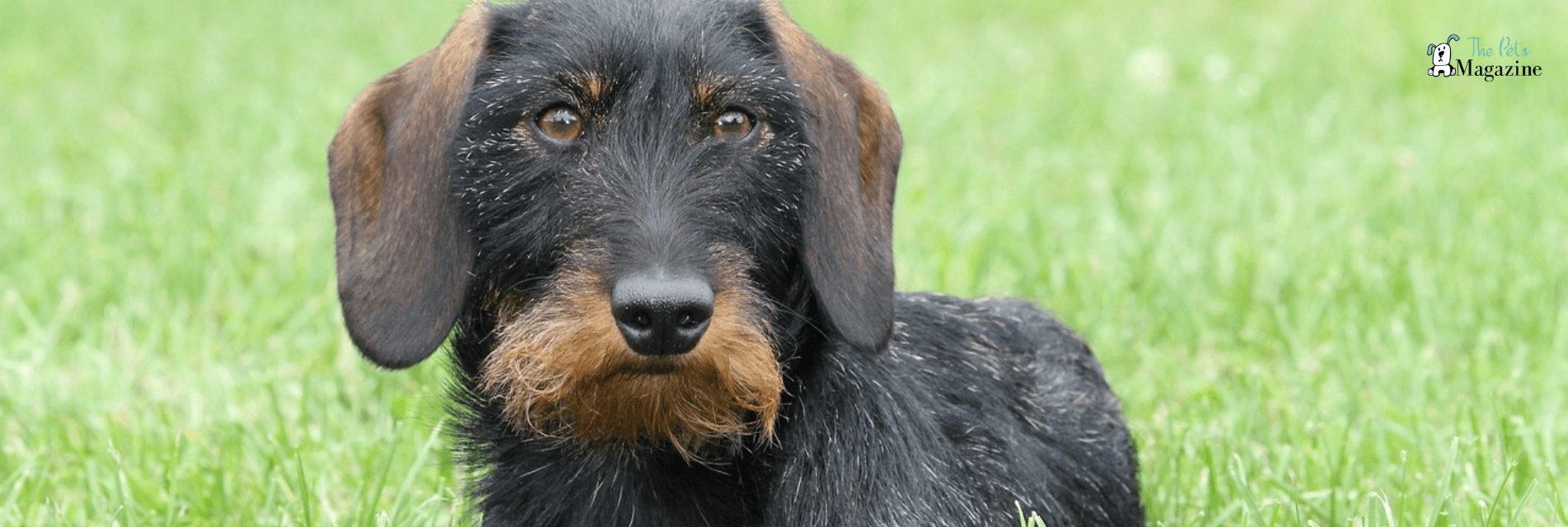
All Comments
17 May, 2024
Hello there, just becaame alert to your blog through Google, and found that it iss really informative. I will apprciate if you continue this in future. Numerous people will be benefited from your writing. Cheers!
Reply